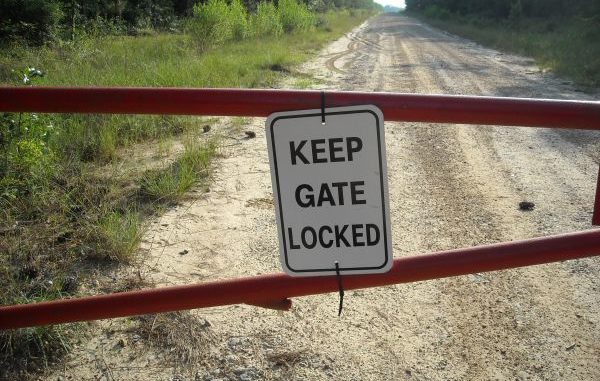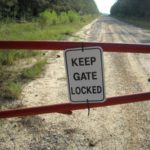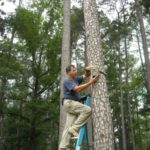
Can you believe it is July already? Time to start thinking about hunting season, paying the lease fees, and getting out to the deer stands and food plots for clean-up and repairs.
A lot of sweat and hard work, not to mention substantial financial investments, go into creating good, quality hunting on private land.
All too often trespassers, poachers and vandals reap the benefits of our hard work and dollars spent in the woods. In this installment we’ll take a look at trespassing and theft problems and ways to deal with them.
If you don’t have trespass problems on land owned or leased for hunting, count your blessings. Few escape this plague, and it certainly does not mean future invasion won’t take place.
The problem is very prevalent, and wildlife enforcement agents are flooded with calls each hunting season. The first thing to understand and accept is that wildlife agents do not enforce trespass on private land.
Why? There are a number of reasons.
For one thing, the shear number of trespass complaints far exceeds manpower capabilities, particularly when agents are already overrun with wildlife violation complaints.
Also it is often unclear as to who may legally have access to the land and who does not.
During hunting season agents really don’t have time to find, apprehend and transport trespassers to lock-up only to have the landowner decline to press charges.
The deal they will offer is this: If an agent encounters someone on private land whose right to be there is questionable, he will check for wildlife violations, deal with those and notify the landowner of the person’s presence.
If the landowner wishes to press charges through the sheriff’s office, the agent will provide a sworn affidavit and serve as witness to the trespass.
That does not mean agents won’t address wildlife violations on private land, and such violations should be reported without delay.
This procedure works well, and one good example comes to mind.
A land manager I knew reported that he suspected poaching during deer season on the land he managed. He had a pretty good idea who the offender might be.
The suspect was a known wildlife violator who lived just across the road from the land. A little foot patrol led me to some footprints on a trail leading from the property, under the fence and past the “POSTED” signs, leading in the direction of the poacher’s home.
I staked that out a few days later, and around mid-morning spotted a man and woman armed with long guns walking the trail coming off the property.
I met them at the fence, identified myself and asked to see hunting licenses. Neither could produce licenses or hunter’s orange, but the guy assured me he had permission to hunt the property.
They were cited for the offenses, and I later notified the land manager. He confirmed this was indeed the suspected trespasser and a girlfriend, and happily filed charges with the sheriff’s office along with a copy of my wildlife offense report.
Trespassing may not be only for the purpose of poaching. Camp burglaries and theft are on the rise, as well. More and more hunters are reporting theft of deer stands, feeders, game cameras and everything else left unprotected in the woods.
One of the best ways to prevent such theft is to restrict vehicle traffic on the property. If possible, construct and lock gates on private roads, and keep those gates locked. Most thieves won’t target places they can’t easily access by vehicle.
Locked gates also protect wildlife on the property from drive-by poaching. A large percentage of wildlife poached from both public and private land is shot from vehicles along roadways.
During my career, no more than one in 10 of the illegal night-hunter apprehensions I was involved with were poachers on foot. Most were hunting from vehicles on roads. In addition, if someone is driving around the gate to get on or off the property, we know we have a problem with unwanted guests.
Public roads through privately owned or leased land are a real problem. I was on a lease a couple of weeks ago helping a friend with a hog problem. The land was laced with public roads, and my friend showed me where a fine gobbler had been shot from the road during deer season.
The sorry character who shot the big turkey had taken only the beard and left the remainder of the bird untouched, not even claiming the spurs.
In those situations and when possible, place stands where you can watch the road, as well as your hunting area during seat time in the stand. The road poacher likes to “hunt” during prime time, too, and a vehicle slowly cruising back and forth during prime hunting time is a dead giveaway. Get a good vehicle description and license plate and report it. The wildlife agent will know what to do.
Game cameras offer excellent surveillance in places other than food plots and game trails. I have used them to monitor traffic on roads and ATV trails, and to identify the dog stealing shoes off the porch at night. Clever devil he was.
A couple of years ago, a landowner tired of having his deer feeders, stands and, yes, even his game cameras stolen from his property used his head and a camera to catch the thief. He placed a camera aimed at a feeder, and then carefully concealed another camera high in a tree aimed at the first camera.
Sure enough, he got photos of the thief removing the camera by the feeder, and the sheriff’s office was able to arrest the offender and had an air-tight case.
Next month we will talk more about poaching and trespass, and ways to combat this widespread problem. We’ll take a look at ways to detect poachers on your land, how to identify them and which land areas are most vulnerable.
Don’t get overheated mowing that food plot, and keep the wasp spray handy.




